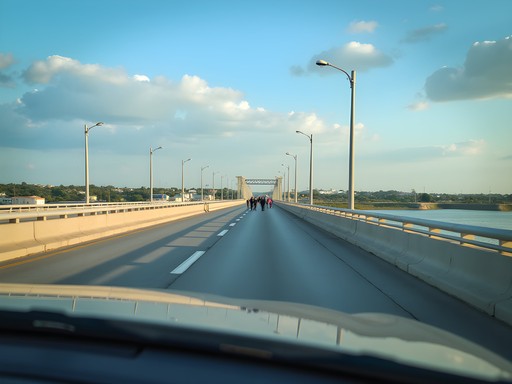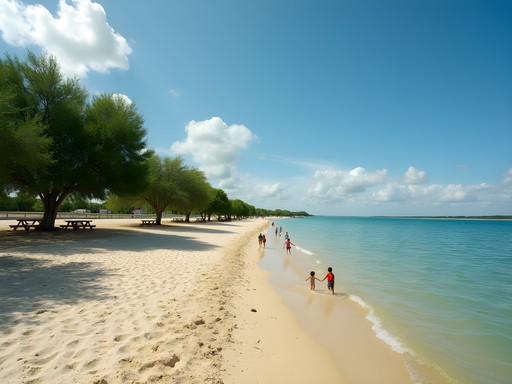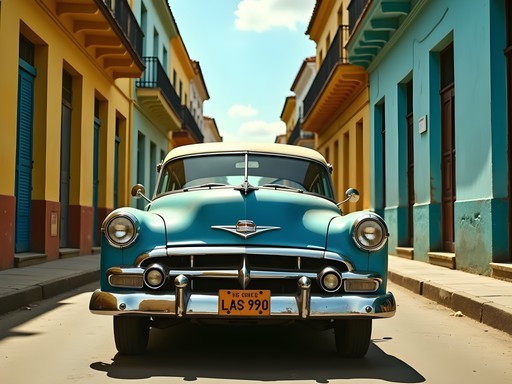Disclosure: This article contains affiliate links. We may earn a commission from purchases at no extra cost to you, which helps our travel content.
The invisible line dividing nations has always fascinated me. As someone who's cycled across Southeast Asian borders and navigated countless immigration checkpoints, I find border towns particularly captivating—these liminal spaces where cultures blend and transform. The Laredo-Nuevo Laredo crossing between Texas and Mexico is one such threshold, pulsing with energy and stories of movement. After spending a weekend exploring both sides recently, I'm sharing my experience navigating this significant portal between two nations that, despite political narratives, remain inextricably connected.
Understanding Your Border Crossing Options
Laredo offers four distinct border crossings into Mexico, each with its own character and practical considerations. The Gateway to the Americas Bridge (Bridge I) connects downtown Laredo directly to Nuevo Laredo's center—ideal for pedestrians seeking an immersive experience. The Juárez-Lincoln International Bridge (Bridge II) primarily serves passenger vehicles and can become quite congested during peak hours. The Colombia Solidarity Bridge, located about 20 miles northwest, offers a less crowded alternative for those willing to travel slightly out of the way.
As someone who values both efficiency and experience, I opted to cross as a pedestrian via Bridge I, then return through Bridge II by bus. This combination allowed me to fully appreciate the transition between countries on foot while experiencing the region's public transportation system. For tracking wait times (crucial for planning), I relied on the border wait time app which provided real-time updates and helped me avoid the worst congestion.

💡 Pro Tips
- Cross early morning (before 8am) or mid-afternoon (2-4pm) for shorter wait times
- Pedestrian crossing at Bridge I costs $0.75 USD each way, payable in quarters only
- Keep your passport accessible but secure in a neck wallet to avoid fumbling at checkpoints
Documentation and Border Procedures
Proper documentation is non-negotiable when crossing international borders. For US citizens, a valid passport is required for re-entry. Non-US citizens should carry both passport and appropriate visa documentation. When entering Mexico for less than 72 hours and staying within the border zone (approximately 25km from the border), no additional Mexican visa or permit is typically required for most nationalities.
The process itself follows a predictable rhythm: exit one country, cross the physical border (often the bridge spanning the Rio Grande), then enter the next country. When entering Mexico, customs officials may ask about your purpose of visit and length of stay. Upon return to the US, expect more thorough questioning and potentially a brief search of your belongings.
I keep all my important documents organized in a travel document organizer with separate compartments for passports, permits, and currency. This simple organization system has saved me countless headaches at immigration checkpoints across four continents.

💡 Pro Tips
- Make photocopies of your passport and store them separately from the original
- US citizens should check if their passport card is sufficient if only visiting the border zone
- Be prepared to declare any purchases when returning to the US
Public Transportation Options
Navigating public transportation between Laredo and Mexican destinations requires a blend of patience and adaptability—qualities any seasoned traveler develops over time. From my experience cycling through Vietnam's chaotic traffic to New Zealand's orderly transport systems, I've found that understanding local transit patterns is essential.
The most economical option for reaching Nuevo Laredo from downtown Laredo is El Metro, the local bus system. Route 16 stops near Bridge I, costing just $2. Once in Mexico, 'peseros' (local minibuses) connect Nuevo Laredo's center to outlying neighborhoods for about 15 pesos (less than $1 USD).
For longer journeys into Mexico's interior, the Nuevo Laredo bus terminal offers connections to Monterrey (2 hours), Saltillo (3.5 hours), and beyond. I was impressed by the digital translator I brought along—it helped me decipher bus schedules and communicate with drivers when my Spanish vocabulary failed me.
For those seeking more comfort, authorized taxi services operate on both sides, though prices increase significantly after dark. I recommend using only official taxis identified by their numbered medallions.

💡 Pro Tips
- Download the Laredo El Metro bus app for real-time route information
- In Mexico, always confirm the taxi fare before entering the vehicle
- Carry small denominations in both USD and Mexican pesos for public transportation
Crossing with Personal Vehicles
Driving your own vehicle across the border introduces additional considerations that pedestrians don't face. Having navigated rental cars through rural Japan and my trusty bicycle across Thailand, I understand the freedom and complexity personal transportation brings to border crossings.
Before driving into Mexico, you'll need Mexican auto insurance, as US policies typically don't provide coverage. I recommend purchasing this online before your trip rather than at the border where options are limited and often overpriced. For short visits within the border zone, a temporary vehicle import permit isn't required, but venturing further into Mexico's interior necessitates this documentation.
The vehicle inspection process when entering Mexico is usually brief, but returning to the US can involve longer waits and more thorough examinations. I found the car organizer invaluable for keeping all vehicle documents, insurance papers, and travel essentials within easy reach during these inspections.
Bridge II (Juárez-Lincoln) and Bridge III (Colombia-Solidarity) accommodate vehicles, with Bridge II typically experiencing the heaviest traffic. If time permits, the Colombia-Solidarity Bridge often offers significantly shorter wait times despite being located about 20 miles outside central Laredo.

💡 Pro Tips
- Purchase Mexican auto insurance online at least 24 hours before crossing
- Keep vehicle registration and proof of insurance easily accessible
- Consider crossing during non-peak hours (avoid Friday afternoons and Sunday evenings)
Safety and Cultural Considerations
Border regions often carry complex reputations that don't fully reflect the daily reality. As someone who values cultural immersion and authentic connections, I approach safety with informed awareness rather than fear. The Laredo-Nuevo Laredo crossing, like many border zones, requires common-sense precautions while remaining open to genuine experiences.
I follow several principles when crossing any international boundary: respect local customs, dress conservatively, limit nighttime activities until familiar with the area, and maintain awareness of surroundings. In Nuevo Laredo, I found the main tourist and shopping areas well-patrolled and welcoming during daylight hours.
Language barriers can create safety challenges. While many officials speak some English, basic Spanish phrases enhance both safety and cultural connection. I always carry a pocket Spanish phrasebook despite my translation app, as technology can fail when most needed.
Money management requires particular attention at borders. I use a hidden money belt for larger sums while keeping small denominations in an easily accessible wallet. ATMs in Laredo (US side) typically offer better exchange rates than currency exchange booths, though having some pesos before crossing is advisable.

💡 Pro Tips
- Register your trip with your country's embassy or consulate before crossing
- Avoid displaying expensive electronics or jewelry in public
- Save emergency contacts including the nearest consulate in your phone
Final Thoughts
As I stood on the international bridge watching the Rio Grande flow beneath—a river that connects rather than divides—I reflected on the artificial nature of borders and the very real human experiences they create. Crossing between Laredo and Mexico offers more than mere transportation between points; it provides insight into the complex relationship between neighboring nations and the resilient communities that thrive in these in-between spaces.
Whether you're a day-tripper seeking authentic Mexican cuisine, a shopper hunting for artisanal crafts, or an adventurer using Laredo as a gateway to Mexico's interior, understanding the practical aspects of this crossing empowers you to move between worlds with confidence and respect. The border may be a line on a map, but the experience of crossing transforms it into a space of cultural exchange and personal growth.
As we navigate increasingly divided global landscapes, these border experiences remind us of our shared humanity. Bon voyage et bonne chance on your own border crossing adventures—may they be as enlightening as they are seamless.
✨ Key Takeaways
- Plan border crossings during non-peak hours to minimize wait times
- Carry proper documentation organized and easily accessible
- Learn basic Spanish phrases to enhance both safety and cultural connection
- Use official transportation options and verify costs before departing
- Approach the border with informed respect rather than unfounded fear
📋 Practical Information
Best Time to Visit
year-round (avoid holiday weekends)
Budget Estimate
$50-100/day depending on activities
Recommended Duration
1-2 days
Difficulty Level
Moderate
















Comments
cooldiver
THANK YOU for mentioning the FMM form requirements!!! We almost got turned away last year because we didn't have them properly filled out. This guide is gold! The reflection about the Rio Grande connecting rather than dividing really hit home. Beautiful writing, Ana!
wavechamp
Is it safe to drive my own car across? Heard mixed things about insurance requirements.
mountainphotographer
Did it last year - you definitely need Mexican insurance, your US policy won't cover it. I used Baja Bound online, super easy process.
Ana Armstrong
Mountainphotographer is absolutely right - Mexican insurance is mandatory. Also make sure you have your vehicle title or registration and a notarized letter if it's not your car.
Hunter Thompson
Brilliant write-up, Ana! I crossed here during my Pan-American backpacking trip and the contrast between the two Laredos is mind-blowing. The Mexican side has such vibrant energy! Pro tip for anyone crossing: download maps offline before you go, as my data plan got confused at the border. Also, the market just past immigration on the Mexican side has some of the best street tacos I've had in my LIFE. Don't miss the al pastor from the stand with the blue awning. One thing I'd add - the money changers at the border give terrible rates. Better to withdraw from an ATM once you're properly in Nuevo Laredo.
coolnomad
Great guide! Is it possible to walk across the border or do you need to take transport? Also, how strict are they about the tourist card if you're just going for the day?
Ana Armstrong
Yes, you can absolutely walk across! The Gateway to the Americas Bridge is pedestrian-friendly. For day trips within the border zone (about 25km), you typically don't need the FMM tourist card, but I always recommend having your passport.
Marco Flores
Ana, your reflection on borders as connecting points rather than divisions resonates deeply with me. Last summer, I cycled from Texas through this exact crossing point and continued south through Mexico. The contrast between the official formality of the crossing and the cultural fluidity of the region is fascinating. One tip for readers: I found having a document organizer essential for keeping my passport, FMM form, and vehicle permits organized. The immigration officers definitely appreciate prepared travelers! Also worth noting that the early morning crossing (6-7am) had virtually no wait time compared to midday.
coolnomad
Marco - how was the cycling experience once you got into Mexico? Safe routes?
Marco Flores
Surprisingly good! I stuck to the 85D highway heading south which has decent shoulders. Definitely avoided cycling after dark though. The route to Monterrey was particularly scenic!
wildvibes
Is it safe to cross alone as a female traveler? Planning to visit in November and getting mixed advice from friends.
backpackvibes
I'm female and crossed solo last week. Felt completely safe during daylight hours. Just use normal travel precautions - don't flash valuables, stay aware of surroundings, etc. The pedestrian crossing has plenty of other travelers and officials around.
wildvibes
That's reassuring, thanks! Will definitely stick to daytime crossing.
winterking
Love this! Planning my first border crossing next month. Super helpful!
mountainphotographer
This guide is exactly what I needed! Just crossed from Laredo to Nuevo Laredo last month and wish I'd had this info. The CBX bridge system was efficient, but I got confused about which documents to have ready. Your section on border procedures would've saved me about an hour of anxiety. Also appreciated the insight on bus options - ended up taking a Greyhound and it was surprisingly smooth.
Ana Armstrong
So glad you found it helpful! The documentation part trips up a lot of people. Did you end up using the express lane on your return trip?
mountainphotographer
I didn't know about the express lane until I was already in line! Next time for sure. The regular line took about 90 minutes coming back.
Savannah Walker
Ana, this brought back memories of my first Laredo crossing three years ago! I was so unprepared - didn't have pesos, forgot to fill out my FMM properly, and ended up in the wrong lane with my rental car. What should have been a 45-minute process turned into a 3-hour adventure! Now I cross like a pro thanks to experience (and guides like yours). One tip for anyone crossing with valuables: I use my anti-theft crossbody which has RFID blocking and slash-proof straps. Perfect for keeping documents secure while having hands free to manage luggage. The border officials actually complimented it last time! Also worth mentioning that cell service can get weird in the border zone - download offline maps before you go!
Ana Armstrong
Thanks for sharing your experience, Savannah! That first crossing is always memorable, isn't it? Great tip about the offline maps - the border area can definitely be a connectivity black hole.
backpackvibes
Just did this crossing last week! The public bus from downtown Laredo to Nuevo Laredo was super easy and only cost $2.50. One thing to add - I noticed the immigration officers were much more relaxed with people who spoke some Spanish. Even my terrible Spanish seemed to make the process smoother. Also, the duty-free shops on the US side have decent prices if you want to grab something before crossing.
Venture X
Premium card with 2X miles, $300 travel credit, Priority Pass